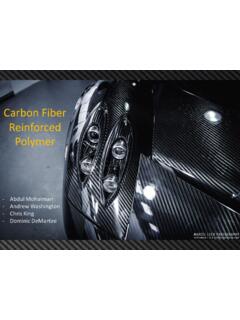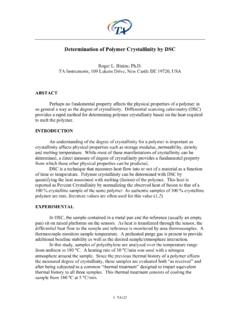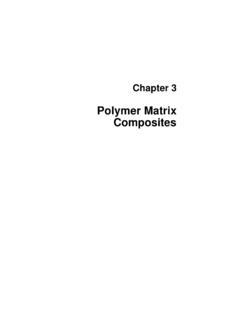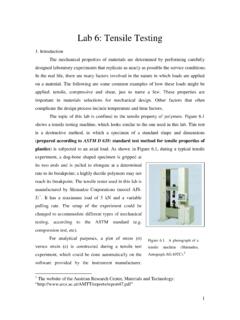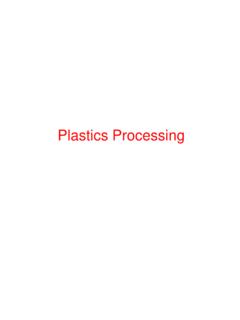Transcription of POLYMER STRUCTURE AND CHARACTERIZATION
1 POLYMERSTRUCTURE ANDCHARACTERIZATIONP rofessor John A. NairnFall 2007 TABLE OF CONTENTS1 Definitions of Terms .. Course Goals ..52 POLYMER MOLECULAR Introduction .. Number Average Molecular Weight .. Weight Average Molecular Weight .. Other Average Molecular Weights .. A Distribution of Molecular Weights .. Most Probable Molecular Weight Distribution .. 123 MOLECULAR Introduction .. Nomenclature .. Property Calculation .. Freely-Jointed Chain .. Chain Analysis .. on Freely-Jointed Chain .. Equivalent Freely Jointed Chain .. Vector Analysis of POLYMER Conformations .. Freely-Rotating Chain .. Hindered Rotating Chain .. More Realistic Analysis .. Theta ( ) Temperature .. Rotational Isomeric State Model .. 484 RUBBER Introduction .. Historical Observations.
2 Thermodynamics .. Mechanical Properties .. Making Elastomers .. Elastomers .. Elastomers .. Elastomers .. 705 AMORPHOUS Introduction .. The Glass Transition .. Free Volume Theory .. Physical Aging .. 736 SEMICRYSTALLINE Introduction .. Degree of Crystallization .. Structures .. 75 Chapter 1 INTRODUCTIONThe topic of POLYMER STRUCTURE and CHARACTERIZATION covers molecular STRUCTURE of POLYMER molecules,the arrangement of POLYMER molecules within a bulk POLYMER material, and techniques used to giveinformation about STRUCTURE or properties of polymers. The subjects are logically combined becauseunderstanding how STRUCTURE affects properties, as measured in CHARACTERIZATION , is a key element ofpolymer materials science and engineering. The subject of POLYMER STRUCTURE and characterizationis typically a second course in POLYMER science.
3 As such it will be assumed that all students havecompleted, as a prerequisite, an introduction to POLYMER materials choose to subdivide POLYMER STRUCTURE into two areas. The first area is analysis of individualpolymer molecules. Molecular STRUCTURE involves the detailed description of POLYMER molecules, theirmolecular weights, and their molecular configurations and conformations. Polymers are random-coil molecules that can exist in a variety of lengths, configurations, and conformations. We canlearn much about POLYMER materials purely by theoretical analysis of their conformations. Manyof the theoretical results can be verified by experiment, but most of our insight is gained by theprocess of doing the theoretical analysis and not by learning about techniques used to verify theanalysis. The second area is the study of how individual POLYMER molecules pack into a solidmaterial to make a bulk POLYMER .
4 POLYMER solids are either amorphous or semicrystalline. Anamorphous POLYMER means a non-crystalline material. A semicrystalline POLYMER means a mixtureof POLYMER single crystals ( POLYMER lamellae) and amorphous POLYMER . These components combineinto supramolecular structures that pack into the bulk material. A POLYMER s properties are stronglyaffected by whether or not is is semicrystalline. For semicrystalline polymers, the properties arestrongly affected by the amount of crystalline material and the arrangement of the CHARACTERIZATION involves measuring any kind of property of a POLYMER material. Itincludes both molecular CHARACTERIZATION , such as molecular weight, microstructural information,degree of crystallinity,etc., and macroscopic property measurement, such as thermal properties,12 CHAPTER 1. INTRODUCTION mechanical properties, microstructural information, time dependence of properties, Polymercharacterization is done with a variety of experimental approaches.
5 Molecular CHARACTERIZATION usescommon methods from physical chemistry and often involves POLYMER solutions. Sometimes spec-troscopic methods can be used . Some common spectroscopic techniques are UV-visible absorptionspectroscopy, infrared spectroscopy (IR), Raman spectroscopy, nuclear magnetic resonance (NMR),electron spin resonance (ESR), and mass spectrometry (MS). These techniques are usually aimedat getting information about the chemical STRUCTURE of POLYMER materials. Macroscopic propertymeasurement is what might be referred to as conventional POLYMER CHARACTERIZATION . It involvestaking a macroscopic POLYMER specimen, often in the final solid form, and doing experiments thatgive information about properties of that POLYMER . Some of the more important properties includethermal properties, mechanical and failure properties, melt viscosity, viscoelasticity properties,friction and wear properties, and electrical Definitions of TermsThe most basic definition is that of a POLYMER .
6 Apolymeris molecule formed by covalent chemicalbonds between atoms (or groups of atoms) to give a large STRUCTURE (linear chains, branched chains,or cross-linked networks). The key word is large. The wordpolymeris usually reserved for highmolecular weight molecules. Historically, the fact that polymers are molecules with ordinary chem-ical bonds ( , with chemical bonds identical to those found in low molecular weight molecules)was not recognized and polymers were once thought to be a distinct state of matter. Becausethis old thinking was wrong and instead polymers are large molecules (or macromolecules), we willfind that most of the principles of chemistry ( , chemical reactions) and physics ( , physicalproperties) apply to polymers just as they do to conventional molecules. In the field of polymercharacterization, we can therefore draw on all the knowledge of the physical chemistry of smallmolecules.
7 Before applying any traditional physical chemistry analysis, however, we must first askabout the effect that large molecular size has on the traditional analysis and then correct for thoseeffects. In one sense, physical chemistry of polymers and POLYMER CHARACTERIZATION can be thoughtof as a subset of physical chemistry. Fortunately the effect of large molecular size is of enoughsignificance that POLYMER science is not a trivial subset of physical chemistry it is a challengingand important types of polymers arenaturalpolymers andsyntheticpolymers. Natural polymers are,as expected, naturally occurring macromolecules. Natural polymers include DNA, RNA, proteins,enzymes, cellulose, collagen, silk, cotton, wool, and natural rubber. Cellulose is the most abundantpolymer, natural or synthetic, on the earth. Despite the unquestioned importance of naturalpolymers, most of the POLYMER and chemical industry is based onsyntheticpolymers or polymersthat can be synthesized by polymerization of low molecular weight monomers.
8 Some DEFINITIONS OF TERMS3synthetic polymers arePolyethylene (PE):(CH2CH2)Polystyrene (PS):(CH2C HHH HHH)Polyvinyl Chloride (PVC):(CH2 CClH)Polytetrafluoroethylene (PTFE or Teflon):(CF2CF2)Polypropylene (PP):(CH2 CCH3H)Other examples of synthetic polymers include nylon, polycarbonate, polymethyl methacrylate (lu-cite), epoxy, polyethylene terepthalate (polyester, mylar), and above structures show therepeat unitof the POLYMER . The repeat unit is usually thesmallest piece of the POLYMER that can be said to repeat periodically to give the POLYMER polyvinyl chloride the repeat unit is(CH2 CHCl). In PE, the repeat unit listed above is(CH2CH2). From a topological point of view, the PE repeat unit could be(CH2), but be-cause PE is polymerized from ethylene or CH2CH2, it is common practice to call(CH2CH2)the repeat unit although it is not the smallest periodically repeating word POLYMER literally means many mers or manymonomers.
9 Monomers are the startingmaterials used in synthesizing polymers. Polymers are made by combining many monomers. Therepeat unit and the monomer are usually closely related. Sometimes ( , in condensation and moststep-reaction polymers) some atoms are lost ( , a molecule of water (H2O)) from the monomerduring polymerization and the repeat unit will differ slightly from the monomer. The names ofpolymers often indicate the starting monomer material. Thus polytetrafluoroetheylene is a polymermade by polymerizing tetrafluoroethylene a POLYMER is made from only one type of monomer or if it has a single repeat unit, it is calledahomopolymer. If a POLYMER is made from more than one type of monomer or has more than asingle repeat unit, it is called acopolymer. Some polymers are made up of alternating monomersor alternating repeat units. Such polymers are often made from two types of monomers and thusare formally copolymers.
10 However, it is possible to consider two consecutive monomer units in thepolymer chain as a single repeat unit. As there is then only one type of repeat unit, it is common4 CHAPTER 1. INTRODUCTIONHO C (CH2)4 C OH + H2N (CH2)6 NH2 (N C (CH2)4 C N (CH2)6) OOOOHHF igure : Copolymerization of the two monomers, adipic acid and hexamethyl diamine, result in synthesisof the POLYMER Nylon 6 to refer to such alternately copolymers as homopolymers. A good example is Nylon6/6. The polymerization of Nylon 6/6 is shown in Fig. Nylon 6/6 is actually an alternatingcopolymer polymerized from monomers of adipic acid and hexamethyl diamine. Although it isa copolymer, the STRUCTURE on the right side Fig. can be viewed as the single repeat unit forNylon 6/6. The 6/6 in the POLYMER name denotes the number of carbon atoms in each of thetwo monomers. The first gives the number of carbon atoms in the amine; the second gives thenumber of carbon atoms in the acid.


